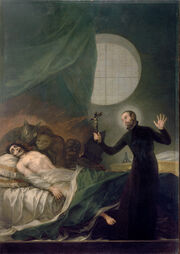Francis Borgia's Dagger was a mysterious knife that haunted Artie's dreams after he used Ferdinand Magellan's Astrolabe to reverse the destruction of the Warehouse.
Background[]
The dagger was first seen in Artie's vision after he used the astrolabe to restore the Warehouse, in the wake of the destruction caused by Walter Sykes. In the vision Claudia appeared to be hunting him and stabbing him with a knife. Since then, Artie began searching for the dagger using the Warehouse database, hoping to locate it and prevent Claudia from using it. After having no luck in his search, Artie recruited H.G. Wells to find any clues concerning its whereabouts. Helena reported having found clues to the location, but ended up putting the notes on paper to leave with Leena just in case.
The artifact's purpose was revealed when Evil Artie began searching for the dagger along with the Chinese Orchid. It was revealed that the dream Artie had was a way for his "dark side" to trick him into searching for the dagger to use on the case covering the Orchid. The dagger was eventually found at a museum in Prague—and used to release the Chinese Orchid plant from its case, and shortly afterwards used again by Claudia to stab Artie in the chest to expel the Evil personality. It was used by the Jesuit Priest for his first Exorcism.
Properties[]
Separates something good from something evil like the orchid (evil) from the case (good) and evil Artie from real Artie.
Real World Connection[]

St. Francis Borgia Helping a Dying Impenitent
Saint Francis Borgia, a.k.a. Francesc de Borja or Francisco de Borja (October 28, 1510-September 30, 1572) was the 4th Duke of Gandía, the third Father General of the Jesuit Order, and the third Superior General of the Society of Jesus. As a child he was very pious and wished to become a monk; his family sent him instead to the court of the Holy Roman Emperor Charle V. In 1539, he convoyed the corpse of Isabella of Portugal, Philip ll of Spain's mother, to her burial place. It is said that, when he saw the effect of death on the beautiful empress, he decided to "never again serve a mortal master." At age 33 he retired from his position as the 4th Duke of Gandía and decided to dedicate his life to Jesus Christ and the Catholic Church. In 1546 his wife Eleanor died, and Francis was then determined to enter the newly formed Society of Jesus. In 1550 he became a Jesuit priest and in 1554, he became the Jesuits' commissary-general in Spain; and, in 1565, the third Father General and Superior General of the Society of Jesus. His successes during the period 1565-1572 have caused historians to describe Francis as the second greatest Father General. Yet, despite the great power of his office, Francis led a humble life, and was widely regarded in his own lifetime as a saint. Francis Borgia died on 30 September 1572, in Rome and became an official saint on 20 June 1670.
In 1788, Spanish romantic painter and printmaker Francisco Goya painted an image of Saint Borgia performing an exorcism.
Trivia[]
- Francis Borgia was never mentioned by name in the show; he was only ever referred to as "the 4th Duke of Gandía" and "a Jesuit priest".
Appearances[]
- A New Hope (vision)
- An Evil Within (shows up on the Unsnagged Artifact Database)
- Personal Effects (pictured, vision)
- There's Always a Downside (vision)
- Fractures (vision)
- Endless Wonder (mentioned)
- Second Chance (mentioned)
- We All Fall Down (actual appearance)
- The Living and the Dead